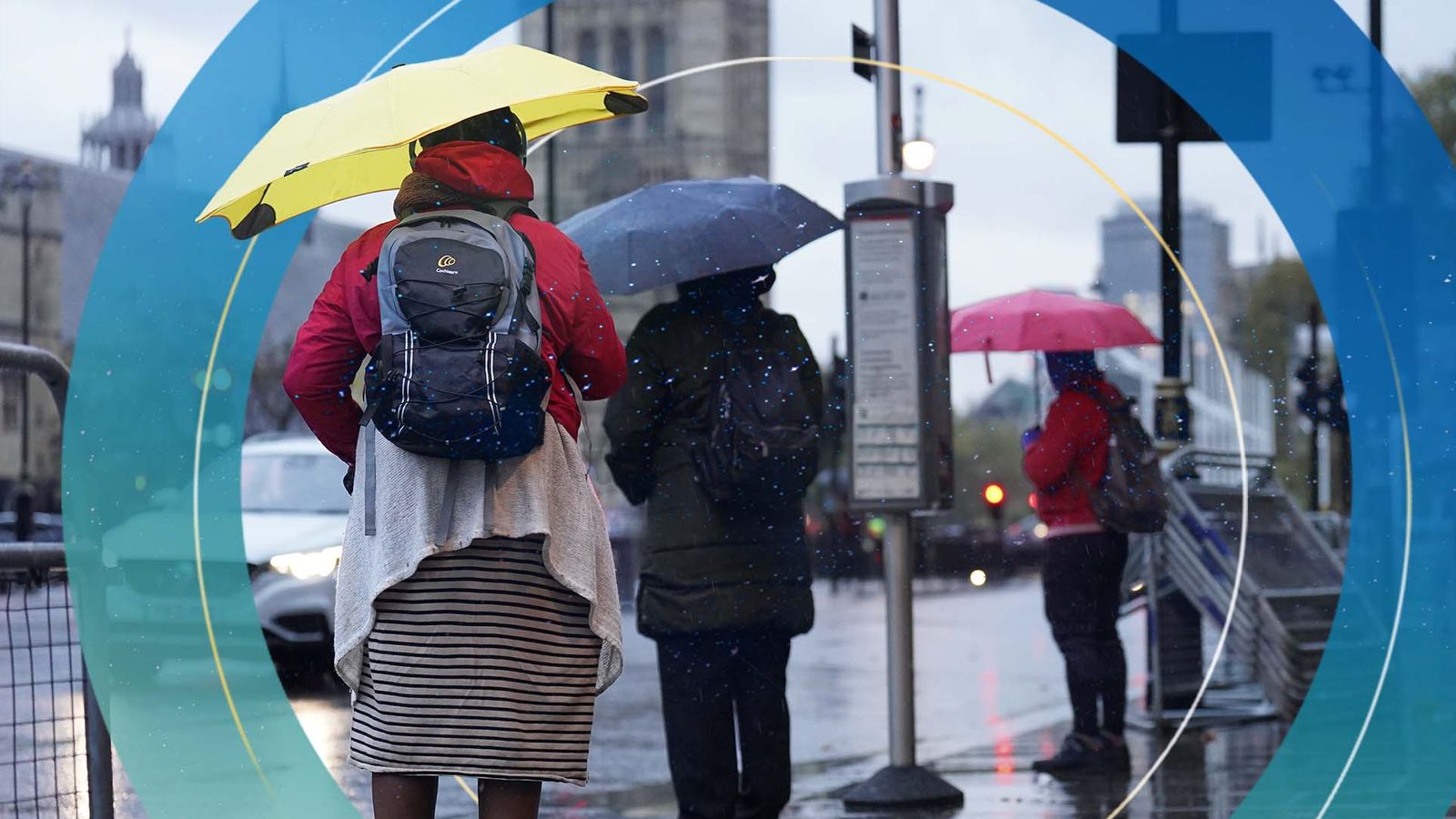Explainer
Why are there still hosepipe bans when it’s been raining so much?
Four water companies in England – South East, South West, Thames, and Yorkshire – still have “temporary use bans” in place. Southern and Welsh Water recently lifted restrictions after water levels in their regions improved.
Lara Keay
News reporter @LaraKeay
Friday 18 November 2022 18:15, UK
Downfalls in London this month
Why you can trust Sky News
Heavy rain throughout November may have left some wondering why hosepipe bans are still in place in parts of the country.
Four water companies – South East, South West, Thames, and Yorkshire – still have “temporary use bans” restricting the amount families and businesses can use.
Southern and Welsh Water recently lifted restrictions they imposed in the summer after supplies improved, but officials in Wales warned that reservoir levels in the southeast of the country are still dropping.
What are the water companies saying?
South East Water said its current hosepipe ban will remain in place “for the foreseeable future”.
This is because water levels at reservoirs and aquifers are “much lower than normal after the dry, hot summer”, its head of water resources Lee Dance said.
He added: “Although we are receiving some much-welcome rain in the South East, we will continue to monitor rainfall through the winter and evaluate whether changes can be made.”
MORE ON UK WEATHER
A motorist drives along a flooded road in Mountsorrel, Leicestershire. Motorists are being warned to stay off the roads as cars have become stuck in flood water caused by downpours and the UK prepares to suffer “miserable conditions” over the next two days. Picture date: Thursday November 17, 2022.
UK weather: Heavy rain and flood warnings as UK set for ‘atrocious’ conditions this week
A man shelters under an umbrella as he walks in the rain near Wells Cathedral, Wells, Somerset.
UK weather yellow warnings issued as heavy rain expected in several parts of Britain
Flag bearers, veterans and members of the public observe a two minute silence an Armistice Day service to mark the anniversary of the end of the First World War, at the WW1 Memorial, in Guildhall Square, Portsmouth. Picture date: Friday November 11, 2022.
Warmest Remembrance Day ever on record and high temperatures are set to continue
Related Topics:
Uk Weather
South West Water only has bans in areas where water levels are “especially low”.
It said recent rainfall has helped river and reservoir levels “slowly start to recover” but supplies remain reduced throughout the region – especially in Cornwall.
Yorkshire Water strikes a more hopeful tone, saying: “Reservoir levels are moving in the right direction.
“We’re seeing some significant increases week on week as the rainfall, drought permits, additional leakage activity and support from our customers to save water, help them to top up.”
But it added that “rain doesn’t always fall evenly across the whole region” and that South Yorkshire in particular still has low level reservoir levels.
A van is left stranded in the floodwaters of the River Adur near Shermanbury in West Sussex
Image:
The River Adur flooded near Shermanbury in West Sussex
When it introduced its ban on 24 August, Thames Water cited low groundwater levels across the region and “significantly reduced” supplies at reservoir stores in London and Oxfordshire.
At the time, it had to withdraw 120 million litres from its North London Aquifer Recharge System underground.
A spokesperson said that “due to recent wet weather, our water resources have begun to replenish”.
But it cautioned that rivers and groundwater have needed “a lot of refilling” and it is “reviewing the situation on a weekly basis”.
Why isn’t the recent rain doing enough?
With temperatures exceeding 40C (104.5F) this summer, 2022 has been the driest year on record since 1976.
Water companies had to increase their water supply by 40% in some areas – the equivalent of hundreds of millions of litres.
After drawing on those reserves, 11 of 14 areas in England are still in drought – despite it raining most days in November.
According to the Met Office, by November, the UK would usually expect to have seen 88% of average rainfall for the whole year.
But the country as a whole is currently falling well short of that – at 76% or 879mm of rain.
And England and Wales have seen even less – at 70% (605.8mm) and 68% (1001.2mm) respectively.
Rain fall in 2022 has been below average so far
Scotland and Northern Ireland are doing slightly better at 82% and 83%.
A Met Office spokesperson described current rainfall levels as “still well below average”.
They added that although it has “boosted totals slightly… it hasn’t been enough to bring them back to average for the whole year”.
A man sunbathes in a nearly empty Greenwich Park, London, as a drought has been declared for parts of England following the driest summer for 50 years
Image:
Scorched grass in Greenwich Park, southeast London, this summer
Why are some regions struggling more than others?
Different regions get their water from different sources.
In England and Wales, two thirds of the water in our taps comes from reservoirs, rivers and lakes, (surface water).
Scotland and Northern Ireland use almost exclusively surface water because they have more rivers and lakes than the rest of the UK does.
The rest comes from aquifers, which are underground permeable rocks that absorb rainwater from the soil above.
Dr Mike Rivington, an ecologist at the James Hutton Institute, tells Sky News that this year’s “exceptional summer” will mean less water on the ground and moisture in the soil.
“Below average rainfall by November will create a deficit of soil moisture,” he says.
“Drier soil and higher temperature also mean more water goes back into the atmosphere instead of soaking into the ground.
“That’s why we’ve still got hosepipe bans in places because those groundwater supplies need recharging.”
A motorist drives along a flooded road in Mountsorrel, Leicestershire. Motorists are being warned to stay off the roads as cars have become stuck in flood water caused by downpours and the UK prepares to suffer “miserable conditions” over the next two days. Picture date: Thursday November 17, 2022.
Image:
Flooded roads in Leicestershire
Although England as a whole uses a third of groundwater, southern England relies on it for 80% of its supply.
This is why half of the areas still covered by hosepipe bans are in southern England.
According to Met Office data, the East, South East, South West, and central parts of England have had the lowest levels of rainfall so far this year, along with Wales.
At county level – Norfolk and Suffolk have been the driest on average, they add.
Read more:
Every household in Wales offered a tree
Tensions soar at COP27 climate summit
People walk through the rain in Seaham, County Durham. Motorists are being warned to stay off the roads as cars have become stuck in flood water caused by downpours and the UK prepares to suffer “miserable conditions” over the next two days. Picture date: Thursday November 17, 2022.
Image:
Locals walk in the rain in County Durham
Winter key for ‘recharging’ water levels
The wet winter period is very important for replenishing or “recharging” water supplies heavily drawn on in the summer.
But with below-average rainfall, deficits will remain and are likely to result in another round of drought in 2023.
According to the Met Office, if the UK gets any less than 80% of its normal rainfall this year, large parts of the country will be in drought again next year.
Dr Rivington says: “It’ll be really interesting to see, given the climate projections we’re looking at, what happens this winter.
“And whether it’ll be enough to prepare us for another hot summer.
“If we don’t get enough rainfall, we start from an even lower point for next summer, and it’ll become an exacerbating problem.”
He adds that if the winter is particularly cold, that could mean less precipitation from rain and snow – and even less groundwater for next year.






























